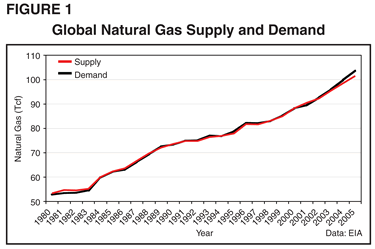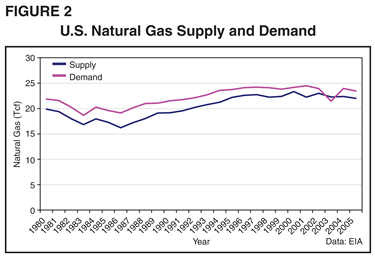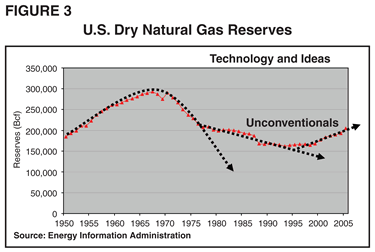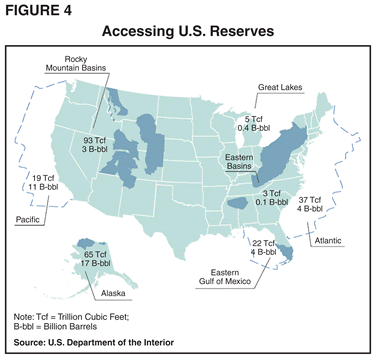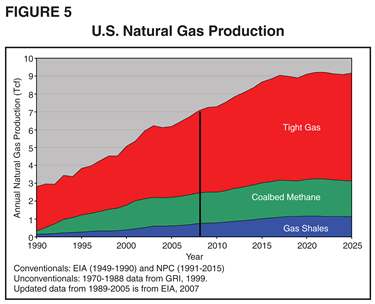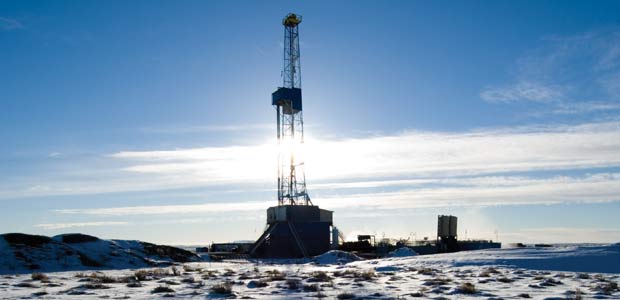
Natural Gas Poised For Growth As World Makes Long Transition To Renewable Energy Sources
By Scott W. Tinker
AUSTIN, TX.–The bridge from a fossil-energy present to an alternate-energy future will span many decades. As with the building of any bridge, a solid foundation is vital. A well-built energy bridge can move the world ahead reasonably smoothly. Heedlessly accelerating an energy transition, on the other hand, could lead to instability and economic collapse.
Building the energy bridge will not be easy; challenges abound. Automobiles will depend on liquid fuels into the foreseeable future; home insulation must be vastly improved. Electricity does not store well, and electricity transmission systems are inefficient. As electricity continues to grow as a percentage of the energy mix, a grand challenge will be to ameliorate disruption caused by breakthroughs in electricity storage and transmission.
Fossil fuels represent 87 percent of the global energy mix today; under any stable scenario the foundation to an alternate, cleaner energy future will be built with fossil fuels. Scaling up alternative energy sources such as solar, wind and biomass to meet massive global demand is a formidable, technology-dominated, investment-heavy task, but it can be accomplished using well-considered energy policy.
Unfortunately, challenges often are presented as choices: energy or the environment; fossil energy or alternate energy; economic growth or climate change. A newspaper poll asked whether economic growth was more important than protecting the environment. In June 2007, 48 percent preferred economic growth, and 43 percent protecting the environment; in November, 51 percent economy and 37 percent environment, and in June 2008 it was 63 percent economic growth and 27 percent the environment. What a difference a year–and high oil prices–makes! What is most disheartening about this poll is that it presents an either/or choice.
The United States can develop fossil energy, build the economy, and protect the environment.
The public has both a desire and a need for energy education and reasonable information. Those who understand energy should–in fact, must–help provide information and solutions by helping to move the energy and environment conversation forward. The public needs to understand the energy bridge and its fossil-fuel foundation. Such an understanding will enable decision makers to develop wise energy policy–something they have been incapable of doing for many decades.
A carbon-constrained economy is coming and, in fact, has been developing naturally, driven largely by energy efficiency, for the past century. Progress toward an alternate energy world will not occur overnight because of the time and technology needed to scale alternate energy projects to commercial levels and the cost of building the needed infrastructure.
Demand Forecasts
Although most forecasts of energy demand and supply are smooth, reality will be more volatile and events will cause positive and negative spikes, as has been seen in the past few months with the price of oil. A less volatile factor, barring major natural or man-caused disasters, is the world’s ever-increasing demand for energy. Natural gas plays a substantial role in satisfying that demand (Figures 1 and 2).
There was a time in the early 1970s when it was hard to argue that U.S. natural gas reserves and production had peaked. Today people don’t talk as much about “peak gas” because reserves again are increasing as a result of research, technology, and price combining to create an unconventional gas industry. In fact, after several years of flat to declining output, total U.S. natural gas production went up last year, with dry gas production surpassing 19 trillion cubic feet for the first time since 2003.
As recently as eight years ago, the Barnett Shale was a minor Texas play. Now the Barnett and other unconventional shale-gas systems are becoming a major focus of domestic exploration, drilling, and production operations, accounting for a rapidly growing share of total domestic gas supply.
Unconventional gas production–from formations typically tighter than those in conventional plays and not associated with oil or liquid hydrocarbon production–is one-third of the U.S. annual total and should soon reach 50 percent. Unconventional reservoirs are extending the U.S. natural gas production plateau much farther than forecast by “peakers” (Figure 3).
The world lags the United States in exploiting unconventional gas plays, and U.S. companies and technologists are beginning to take that technology and expertise overseas. Coalbed methane exploration is starting to pick up globally, and shale plays are on the near-term horizon. Shale gas potential in Latin America, the Middle East and China is substantial, and the Former Soviet Union and parts of Asia and China possess significant coalbed methane potential. A Society of Petroleum Engineers paper estimates combined global shale gas, tight gas and coalbed methane resources at more than 32,000 trillion cubic feet, and this does not include the potential of methane hydrates. Current global annual consumption of natural gas is 110 Tcf.
Over the next 20 years, the natural gas industry will rely on new technologies to improve its resource characterization abilities. In terms of conventional gas, seismic and subsalt imaging, remote sensing, and developing surface and downhole equipment that can withstand extreme pressures and temperatures will be important. On the unconventional side, hydraulic-fracturing and horizontal-well-completion technologies top the list. In addition, a fundamental understanding of the rock-fluid system could improve drilling success rates and maximize economic return. Characterizing systems accurately is going to be an important part of intelligent development in new basins.
A natural gas price range of $7.00-$8.00 an Mcf would make most producers comfortable, although technology can be developed and deployed in many cases with prices as low as $5.00. Of course, political risk must be factored in, as seen in Russia (TNK-BP), Venezuela (ExxonMobil and others), and Bolivia (Petrobras), for example.
LNG
Liquefied natural gas probably will not seriously threaten U.S. natural gas supply, owing to growing demand for natural gas in the power and heating sectors, combined with the time and expense to build shipping and receiving terminals. In fact, LNG terminals in the United States today face the problem of limited supply; most major producing regions have customers closer than North America, and many nations (especially China and industrializing countries along the Pacific Rim) are willing to pay substantially for the natural gas.
The upside to LNG is deliverability, stability and broader confidence in the natural gas industry using a reasonably mature and understood system that has infrastructure already in place.
Some analysts are warning that by relying on natural gas, the United States is setting itself up to repeat its oil experience by having to deal with a possible natural gas cartel. However, as the world adapts to the unconventional gas technologies and expertise developed by U.S. producers, production will grow to encompass developed and developing economies across a broader range of global geopolitical systems. That host of conventional and unconventional sources will allow for market competition and diminish the power of an incipient cartel.
Paying The Cost
One of the big battles playing out in the public arena involves who is going to pay for the research, technology, and infrastructure needed to develop alternative, clean energy. Regardless of who foots the initial bill, ultimately the public will pick up the tab.
One example is found in carbon sequestration. Politicians are promoting a cap-and-trade system to control carbon dioxide emissions, under the assumption that industry will bear the costs, thus sparing the elected officials from appearing to impose taxes. Unfortunately, cap-and-trade activities can be wasteful and will cost more than a simple tax; some of the added cost will benefit speculators and traders and not go toward solving the problem. A tax is more straightforward and predictable. At the end of the day, it will be the public that pays this higher cost, so a carbon tax makes more sense for people.
Of course, the notion of pinning costs on the oil and gas industry is popular. It is an odd time indeed when the federal government can spend enormous amounts of public tax dollars to bail out financial, insurance, and other institutions, while simultaneously proposing further taxing of the industry most critical to our economic well-being: the energy industry.
What makes this situation most worrisome can be found under the hood of integrated oil and gas companies–their engines are not in very good shape. Reserves are not being replaced, operational costs are skyrocketing, talented people are in short supply, experienced employees are retiring in droves, and access to oil and gas is limited and controlled largely (greater than 90 percent) by national oil companies in countries that are not necessarily friendly to the West. Although the increased price of oil has bolstered net revenue (not profits) for a couple of years, it has hidden these otherwise very poor fundamentals.
Despite these difficult financial circumstances, large oil and gas companies continue to invest substantially in alternative energy research and development. It makes sense for these companies to transition into energy companies. Note that they are focusing on ways to make alternate energy commercially viable. Commerciality is required if alternate energies are ever to become scalable to meet substantial energy demand. Unlike governments, stockholders have an odd way of requiring commercial viability.
Government policies that force the pace and cost of alternative energy on the few remaining, fully integrated oil and gas companies are a poor idea and could have unintended negative consequences to the stability of the publicly traded oil and gas industry. The nation will need the major oil and gas companies, as well as large and small independents, to build a stable energy bridge.
Scenarios
Production of conventional oil–hard to find but easy to produce–is reaching a global production plateau. Unconventional oil–easier to find but harder to produce–has a tremendous global resource base and the potential to capture a growing share of oil production. Production of conventional and unconventional natural gas still is growing, with unconventional gas capturing an ever-greater share of total production (Figure 4). The global fossil fuels inventory, including coal, can satisfy a large percentage of energy needs for a couple of centuries, so there is time for an organized, thoughtful effort to bring alternative energy sources on line.
Energy transition could see several interesting scenarios unfold. Because many countries are restricting access to hydrocarbons, one possibility is that the major oil and gas companies will re-enter the United States in a big way. In 2008, BP paid Chesapeake Energy $1.9 billion for a 25 percent position in its Fayetteville Shale assets, gaining access to 135,000 net acres of the 540,000-acre position. Any major seeking access to unconventional resources could buy a large independent with an established unconventional gas asset base.
Another possibility would be service companies, especially those in the international market, shifting to become resource players by taking equity positions. NOCs are reaching out for technology, and often rather than going to the super majors, they are turning to service companies, which have maintained their strong science and engineering talent pools.
Another scenario could be NOCs following the lead of Brazil’s national oil company, Petrobras, and become semipublic–traded on the New York Stock Exchange but exclusively hiring Brazilians. Other NOCs could follow suit and pursue capital in the global marketplace rather than allowing large integrated oil companies, which bring capital and technology, to develop reserves.
The new marketplace could drive large independents toward riskier exploration and production opportunities and increased vertical integration. Whereas with conventional fields, in which the majors made high-risk/high-return investments and independents followed with higher efficiencies, it is the opposite with unconventionals–independents have led the way, and now majors could step in and assume responsibility for later primary and secondary recovery.
Understanding The Rocks
As oil and gas producers continue to pursue unconventional resources, the importance of geologists and geophysicists will grow substantially. In this new frontier, a tremendous amount of detailed nanopore-scale sedimentology, stratigraphy, pore-system analysis, rock physics, and seismic imaging needs to be done.
The oil and gas industry has increased its efforts to recruit the next generation of earth scientists, but the call for young talent will increase in this new environment. To meet tomorrow’s need for geophysicists, geochemists, geomicrobiologists, rock and fluid physicists and beyond, today’s students should be pursuing studies in traditional areas of mathematics, chemistry, physics and biology, as well as courses offering integrated approaches to problem solving.
The rock-and-fluid-system understanding of unconventional fields lags our conventional-system understanding, which, while frustrating, also generates excitement. That challenge is seen in operators’ willingness to drill the next horizontal well, despite not fully comprehending the underlying geology. It is not uncommon to see a well completed on one location producing minimal amounts, while a site one spacing unit away produces an order of magnitude more.
Natural gas in the Barnett Shale is held in nano- and microscale pores, one-millionth to one-billionth of a meter across–an environment in which Darcy’s Law does not necessarily apply. Only a few research laboratories have the technology to prepare Barnett core samples, properly using an ion beam to cut along the rock surface to allow pores as small as 15 nanometers across be observed using a scanning electron microscope.
The microstratigraphy in shale systems has never really been studied. But just like the now well-understood depositional systems in sandstone reservoirs and carbonates, the opportunity to define a shale microstratigraphy is there. Geologists, geophysicists, engineers, chemists and biologists will join forces to open these easier-to-find but harder-to-produce resources.
Things To Come
The amount of uncertainty in climate science is remarkable; so many nonlinear variables are involved that modeling and forecasting remain a challenge. Regardless, climate change is no longer just a scientific concern; polls have shown it to be a social and political issue that must be addressed. Many people, especially the young, want forward motion on climate change. That said, the public is starting to also recognize the magnitude of the cost and to appreciate that “we the people” will ultimately bear that cost. And if costs are borne disproportionately by certain geopolitical regions, there will likely be push-back.
The United States cares about its environment and economy. However, if it removes carbon and in so doing increases the cost of clean electricity, and its global competitors do not follow suit, opposition is likely. More than cost, a U.S-only policy will not reduce global emissions enough to address the global climate challenge.
Natural gas remains one of the more attractive midterm answers to climate change as the United States builds a bridge to future alternate energies. Despite the attention that unconventional reserves have drawn, no one yet has rigorously quantified exactly how much natural gas unconventional systems contain. Even in the United States, where unconventionals account for more than a third of natural gas production, the rest of the book on this topic remains to be written. Some projections see tight gas, coalbed methane and gas shales adding as much as 9 Tcf a year to U.S. production by 2025 (Figure 5).
Methane hydrates will remain off the world’s production projections until the production technology to tap their vast potential is developed. That promise is still unclear. “Tinker’s Axiom” says the less we understand about something, the bigger we think it is. That fits hydrates. However, the research community is starting to understand more as it characterizes methane hydrates geophysically. Some analysts say the world contains more than 15,000 Tcf of hydrate resources. If technology to develop these resources develops, hydrates could satisfy a substantial component of global demand for more than 100 years. Extracting only part of these reserves would comfortably stretch the energy bridge to an alternative energy future.
Policy And Crisis
Before the United States can develop credible energy policy, it must overcome the paradox of discussing energy policy only during times of crisis. Sound energy policy would best be developed when the energy industry and economy are not in turmoil, allowing thoughtful people who understand energy to develop well-considered policy. The public also must get away from the false perception of either/or choices.
One role of the natural gas industry in overcoming the crisis-policy paradox is to educate that public. Natural gas is not clean in the sense of zero CO2 emissions, but it is cleaner than other fossil fuels. It is not completely renewable in that there is a limited resource base, but the world has yet to come close to tapping its reserve potential. The present-day challenge, therefore, is not one of resources but, instead, one of access and transportation–being able to get to and move natural gas around the globe so that it becomes a physical as well as an economic commodity.
T. Boone Pickens’ plan to produce 20 percent of U.S. electricity from wind power in 10 years and use natural gas to run cars is admirable in that it brings attention to the urgency of the issue. His willingness to offer a way forward should be applauded. Some of the challenges to the plan include:
- The need for major new transmission infrastructure, with opposition expected from landowners resistant to large power lines crossing their lands;
- A major compressed natural gas delivery infrastructure to allow fueling of yet-to-be-built CNG vehicles; and
- Permitting, construction, deployment, maintenance, and eventual decommissioning of several times more wind turbines than exist in the United States today combined.
These challenges can be overcome if the United States chooses this path, but they are not trivial and will take major political will.
In terms of the energy bridge, natural gas plays a leading role because it is uniquely positioned in all three end-use sectors: heating, electricity and transportation. In addition to use in CNG automobiles, natural gas also could serve as feedstock to generate hydrogen as a transportation fuel; it is much easier to split a methane molecule that a water molecule.
Fossil fuels represent 87 percent of the global energy mix today; under any stable scenario the bridge to an alternate, cleaner energy future will be built with fossil fuels. New conventional oil and natural gas frontiers include ultradeep water, the Arctic, and other extreme operational environments.
Unconventional oil and natural gas represent a vital part of the future fossil energy mix and require significant research investment. Carbon sequestration offers the greatest promise for large-scale removal of carbon from stationary sources of CO2. Nuclear energy also will play an important global role. Scaling up alternative energy sources such as solar, wind and biomass to meet massive global demand is a formidable, technology-dominated, investment-heavy task, but it can be accomplished using well-considered energy policy.
It terms of broader global policies, the United States must invest in increased efficiency across the board, including cars and light trucks, insulation, and lighting and industrial efficiency. It must diversify the global energy portfolio, including especially liquid transportation fuels from unconventional sources of oil, coal and gas-to-liquids, and certain biofuels and electricity from coal with sequestration, expanded nuclear and investments in other renewables to get them up to scale by 2030.
Finally, the United States must look to an international roadmap that:
- Sets a transparent, predictable, economywide global carbon price (one that is reasonably stable, avoids wasteful activity and uses the revenues wisely) and is coordinated with major developing and developed nations;
- Integrates energy policy into economic and environmental discussions;
- Strengthens global energy trade and investment;
- Broadens dialog between producing and consuming nations to improve global energy security; and
- Evaluates manpower and education opportunities for students and professionals.

SCOTT W. TINKER is director of the Bureau of Economic Geology at the University of Texas at Austin (UT) and the state geologist of Texas, a professor and Allday endowed chair in the Jackson School of Geosciences at UT, and president of the American Association of Petroleum Geologists. Before coming to UT, Tinker spent 17 years in the oil and gas industry. He is a former distinguished lecturer for both AAPG and the Society of Petroleum Engineers, and past president of the Association of American State Geologists. He serves on many private and public boards and councils. Tinker holds a B.S. from Trinity University, an M.S. from the University of Michigan, and a Ph.D. from the University of Colorado.
For other great articles about exploration, drilling, completions and production, subscribe to The American Oil & Gas Reporter and bookmark www.aogr.com.







